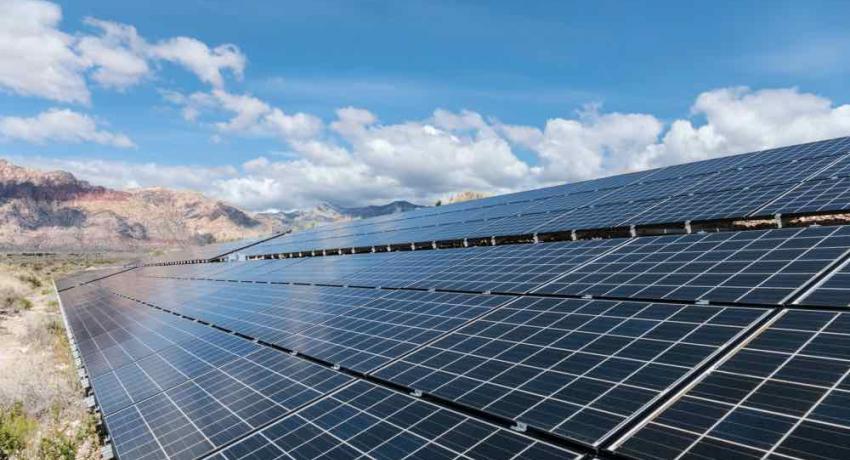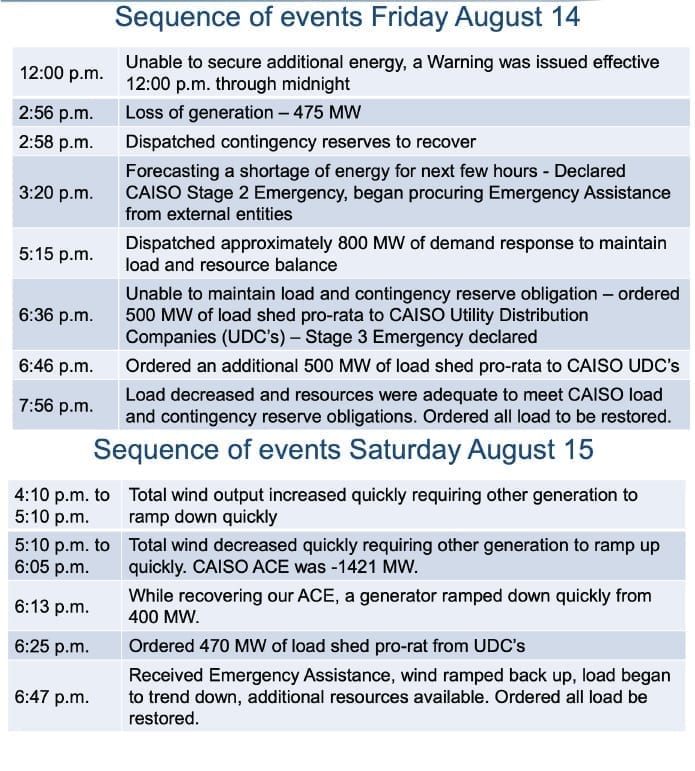California Blackouts Bring Calls for Investigation
The post California Blackouts Bring Calls for Investigation appeared first on POWER Magazine.

California's governor demanded an investigation into the cause of a series of power outages-the first since since an energy crisis in 2001-that blacked out parts of the state in recent days.
California Independent System Operator (CAISO) has struggled to ensure reliability since Friday, Aug. 14, when, amid triple-digit temperatures, it declared a statewide Stage 2 Emergency, warning power outages were possible. Later that day-at 6:36 p.m.-citing 1 GW of lost generation capacity and an ensuing extraordinary strain on the ISO electric system," CAISO escalated the event to a Stage 3 Electrical Emergency and initiated rotating outages throughout the state. By 7:51 p.m., the grid had stabilized as utilities began restoring the lost supply.
 A Timeline of Events
A Timeline of EventsAt a Board of Governors meeting convened by the Gov. Newsom on Aug. 17, John Phipps, director of CAISO's Real Time Operations described how the load shedding events unfolded on Friday, Aug. 14, 2020, and Saturday, Aug. 15, 2020. Note: ACE = Area Control Error. Courtesy: CAISO
The rolling outages were the state's first in nearly 20 years. According to local media, the state's three biggest utilities-Pacific Gas & Electric, Southern California Edison and San Diego Gas and Electric-turned off power to more than 410,000 homes and businesses for about an hour at a time during the event, which lasted around three and a half hours.
However, the grid operator's troubles were exacerbated on Saturday at around 6:28 p.m., when CAISO again declared a Stage 3 Electrical Emergency, citing the unexpected loss of a 470-MW power plant, and loss of nearly 1,000 MW of wind power." Load was ordered back online 20 minutes later as wind resources increased. Though CAISO said it was working closely with California utilities and neighboring power systems to manage strain on the grid and to restore the power grid to full capacity," on Sunday, the grid operator issued a statewide Flex Alert-a call for voluntary electricity conservation-extending through Wednesday. There is not a sufficient amount of energy to meet the high amounts of demand during the heatwave," CAISO warned. (This commentary from an industry expert with Hitachi ABB Power Grids provides more data on the situation.)
On Monday, it again raised the emergency to a Stage 2, citing excessive heat driving up electricity use and putting strain on the grid," and though it anticipated rotating outages totaling up to 1,400 MW spread across the state between 5 p.m. and 6 p.m., it rescinded that warning later the day, citing reduced demand due to consumer conservation and cooler than expected weather." But it cautioned: This heat storm is not over, and we still expect exceedingly hot temperatures tomorrow and Wednesday."
On Tuesday, Aug. 18, CAISO again declared a statewide Stage 2 emergency, and urgently appealed to consumers to conserve energy. At the end of that day, CAISO announced it would not order power interruptions," thanking consumers for conservation efforts. The ISO grid also received some imported energy, and wind plants churned some resources into the system late in the day," it said. On Wednesday, as the state's heat wave dragged into its sixth day, CAISO again called for electricity conservation, noting consumer response had been instrumental in averting power loss for two straight days." Toward the end of the day, CAISO again credited consumers for conservation efforts, even though energy supplies were tight." The supply situation was also again helped by imported energy and increased wind production," it said.
Governor Demands InvestigationThe events have drawn Gov. Gavin Newsom's ire, and in a tweet demanding an investigation into the service disruptions, he blamed energy regulators-the California Public Utilities Commission (CPUC) and the California Energy Commission (CEC)-which failed to anticipate this event and to take necessary actions to ensure reliable power to Californians," he said.
On Monday, Newsom also issued a proclamation to temporarily allow allows some energy users and utilities to use backup energy sources to relieve pressure on the grid during peak times during the energy emergency. He noted state officials worked aggressively" to bring more energy resources online, including increased generation from sources like the Los Angeles Department of Water and Power, the California State Water Project and investor-owned utilities.
These blackouts, which occurred without prior warning or enough time for preparation, are unacceptable and unbefitting of the nation's largest and most innovative state." (1/3)
- Office of the Governor of California (@CAgovernor) August 17, 2020
Meanwhile, while state regulators hinted at mismanagement by CAISO, CAISO President Stephen Berberich delivered a blistering" public rebuke to the CPUC for ignoring CAISO's warnings and failing to act to ensure adequate power capacity on hot summer evenings, as The Los Angeles Times reported.
Observers widely note CAISO had sounded the alarm in a 2019 presentation about looming shortfalls. As he delivered that presentation last September, Mark Rothleder, vice president of Market Quality and State Regulatory Affairs at CAISO, noted that while the ISO supported California's renewable portfolio standard, efforts to uphold it were ridden with serious challenges. CAISO was facing a capacity shortfall in 2020, specifically to meet summer evening peak load, he warned.
The peak demand the ISO serves is shifting from the afternoon to the early evening. Solar production is significantly reduced or not available during, these new, later peak demand hours. Instead, we now rely on energy from natural gas resources and imports," Rothleder said. However, energy capacity is decreasing due to net retirement of 4,000 MW of once-through cooling steam generation; reduced imports due to increasing load, thermal resource retirement, and increasing renewable integration needs outside of California; and potential changes in hydro conditions and availability in [California] and [the West]."
 What CAISO's supply picture looked like at around 7 p.m. on the evening of Aug. 14, 2020, just after it declared a Stage 3 Electrical Emergency. Courtesy: CAISO
What CAISO's supply picture looked like at around 7 p.m. on the evening of Aug. 14, 2020, just after it declared a Stage 3 Electrical Emergency. Courtesy: CAISOThe North American Electric Reliability Corporation (NERC), too, has repeatedly highlighted potential issues at CAISO. In its July 30-released State of Reliability 2020 report, the not-for-profit international regulatory authority warned that in areas with significant amounts of solar PV resources, balancing electricity supply and demand can be especially challenging when the sun is setting and load is increasing. As the sun recedes, the collective contributions of solar PV resources rapidly diminish, leading to a steep ramp-up from dispatchable resources to meet electricity demand." And while CAISO annually assesses the flexible capacity needs to meet reliability criteria so that sufficient resources can be procured, actual three-hour ramps by month for CAISO have been on the rise since 2016, it said.
 An illustration of ramping needs for a simulated system under three levels of solar resource capacity (not an actual system). Courtesy: NERCSpeculation Mounts
An illustration of ramping needs for a simulated system under three levels of solar resource capacity (not an actual system). Courtesy: NERCSpeculation MountsOver the past week, the blame has taken on an ever more political tinge. On Wednesday, The Wall Street Journal's editorial board scathingly said aloud what some in the industry have hinted at: If you eliminate fossil fuels, power shortages are inevitable."
The editorial board said: Caiso in part blamed cloud cover, weak winds and failures at a couple of power plants for this weekend's power outages. But this happens when you rush to shut down power plants to meet government diktats and reduce the amount of reliable baseload power. Unlike fossil-fuel plants, solar and wind can't ramp up quickly when other power generators go down. Solar power also plunges in the evening, and the state didn't have enough backup power to compensate to meet high demand."
Several industry groups have also since sounded off. The American Wind Energy Association (AWEA) deflected criticism that California is too dependent on renewables or is speeding along too quickly to meet its 100% clean energy targets within the next 25 years. However, it appeared to heap blame on the state's emphasis on solar.
Right now, California has a renewable energy system that is heavily reliant on the sun, and solar resources are performing exactly as it should: Solar power can produce huge amounts of energy, but the State needs a better plan for providing clean energy in that evening period when the sun sets," said AWEA Director Danielle Osborn Mills on Aug. 18. Our renewable system in California and across the West is not sufficiently built out, and was designed around a different set of resources. As a result, the State needs to refocus its planning and procurement processes to enable utility-scale wind, solar, and storage to provide reliable power to California before retiring our aging conventional fleet," she said.
Environmental groups urged a more nuanced examination of the crisis. We need first to understand exactly what happened and to appreciate how much worse it could have been, even as we work urgently to address the underlying problems and continue a clean energy transition in which reliability is a cornerstone," said Natural Resources Defense Council (NRDC) Climate and Clean Energy Program's Energy Co-Director Ralph Cavanagh.
Any large-scale electricity service interruptions threaten public health, equity, and economies, and this one sends a clear warning last heard by millions in during the 2001 crisis: we must do more to preserve reliable electricity service, with emphasis now on extreme' weather events exacerbated by the climate crisis. And we must double down on the clean energy solutions that address that crisis head-on, by cutting the carbon pollution emissions at the heart of the problem," he said.
Some groups highlighted a need for resiliency, and for a renewed look at backup power. During this critical time of unprecedented extreme weather conditions, we see again the importance of diesel technology-proven, available and reliable-to key sectors of California's economy and particularly the government's ability to respond to crisis situations and protect and ensure public health and safety," said Allen Schaeffer, executive director of the Diesel Technology Forum, a not-for-profit association representing manufacturers of diesel engines and equipment, key suppliers of emissions control and other technologies and fuel producers.
At times like this, the availability, portability and reliability of diesel or natural gas generators must be weighed against wide-ranging impacts, both economic and on public health and safety of electrical power outages. Disruptions, even in the short term, can be far reaching, including loss of traffic control systems, water treatment facilities, communications outages, risks to food storage and public safety from loss of refrigeration, air conditioning and impacts on other vital services," he said.
-Sonal Patel is a POWER senior associate editor (@sonalcpatel, @POWERmagazine).
The post California Blackouts Bring Calls for Investigation appeared first on POWER Magazine.